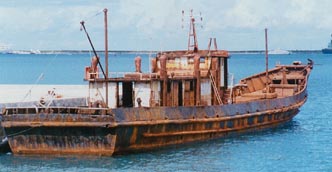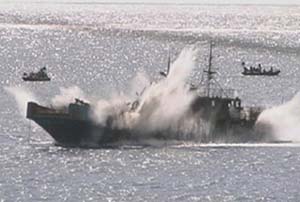Like a scene from "Lethal Weapon IV" the U.S. Coast Guard accosted, boarded and arrested two Chinese ships between Guam and Rota. They were smuggling illegal Chinese Nationals attempting to enter
the United States via Guam. Confiscated vessels are usually either sold or scuttled, depending upon their condition. The U.S. Marshall's office took possession of the ships in Apra Harbor, Guam and
readied them for scuttling. With these two confiscated vessels added to several others the Marshall's office now had a large inventory of vessels that they had no idea of what to do with.
Enter Petty Officer 2nd Class David Callaway of the United States Coast Guard - Station Guam whom coincidentally was personally involved in the boarding and seizure of one of these vessels. As an avid
diver and good personal friend of Dive Rota's owner, Mark Michael, the two had discussed many times in the past during beer therapy about how a more recent ship sunk in our super clear waters would be a
great addition to our dive sites and add a shipwreck training platform. So as an opportunity seemed to be presenting itself Petty Officer Callaway contacted the Marshall's office and asked if they would
like to get rid of one of the vessels in their inventory. Kind of quickly they said how many do you want and when do you want them?
So with the possibility of obtaining a vessel, Mark Michael, of Dive Rota, approached Rota Mayor, Benjamin T. Manglona, proposing to sink one or two ships on Rota to form new dive site and to protect the
damaged reef at Coral Gardens. The Mayor organized a team from his office to spearhead the project and called upon John Gourley, a private environmental consultant from Saipan, for his assistance in
obtaining the proper permits and ensuring that the project would be environmentally friendly as possible.
The U.S. Marshall's office supervised the initial cleaning of the ships, with final cleaning by volunteer effort of the Mayor's office, Dive Rota and Mobil Oil. CNMI Governor Tenorio requested federal
assistance and the permits, were issued for the project.
Towing arrangements were made with the U.S. Coast Guard and IBC - International Bridge Corporation a construction company in Guam. During the cleaning phase all protruding objects and detachable items
were removed to make the vessels safe for divers. The ships were positioned off Sagua in Sasanhaya Bay, near the resting place of the Shoun Maru, a Japanese freighter sunk there in 1945 during WWII.
Local volunteer divers marked the new locations with buoys and prepared the site by salvaging anchors and chain from various parts of Sasanhaya Bay, towing them to the new sites and getting them ready
for attachment to the ships once they were maneuvered into the proper positions with the help of volunteer local boaters.
Officials then had U.S. Navy E.O.D. and SEAL teams sink them. Once the ships were sunk and the area declared safe Mobil Oil with the help of a couple of local boats and crews used this event to practice
their oil pollution capabilities as they skimmed the areas above and around the sunken vessels to capture any oil or fuel that may have escaped during the sinking.
The following day divers secured both vessels with bow and stern anchors to help prevent shifting of the ships from their sunken positions in the event of heavy seas and typhoons.
The Riverboat - Tse Yuen Yui

Photo by David Callaway, U.S.C.G. BM2 - Guam
Originally from the Chinese port of Hongzhou, the riverboat is approximately 124 feet long and has a unique system of seven engines each with a separate gear box, shaft and propeller. There are
five cargo holds and double bottom tanks. Made of welded steel, the riverboat has a raised wheelhouse and superstructure. The wheelhouse has a large wooden helm, a magnetic compass, and a power supply
unit. The steering system includes chain and sprocket, steering spindle and quadrant and rudder. It was built about 1990.
The Stern Trawler / "Snake Eyes Express"

Photo by John Gourley of Micronesia Environmental Services - Saipan
Built as a fishing boat in 1985, the name of the ship was obliterated when its purpose became smuggling. Its displacement is 240 tons and it is 134 feet long. It was sunk in 95 feet of water about
900 feet from the shoreline. To see what it looks like now, check out our customer and friend "Hagihira-san's photo" taken very
shortly after the sinking.
Back to Diving Sites

Dive Rota, P.O. Box 941, Rota MP 96951
E-mail: mark@diverota.com
Home /
About Us /
Airline Services /
Contact Us /
Current Events /
Diving Sites
FAQ /
General Information /
Links /
Places to Stay /
Visitors Photo Gallery /
What to do on Rota
Copyright © 2019
|






